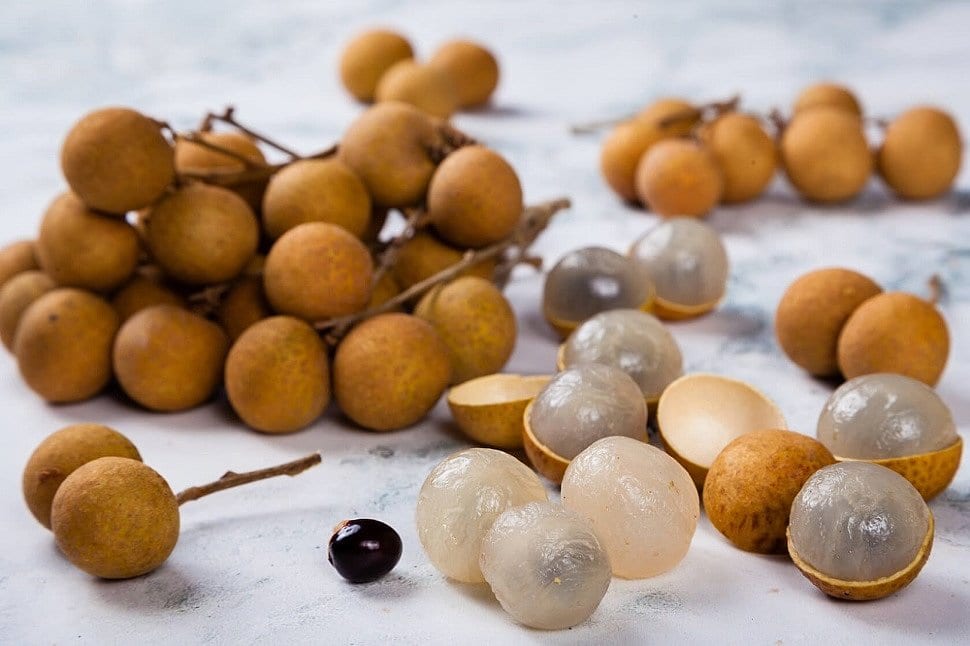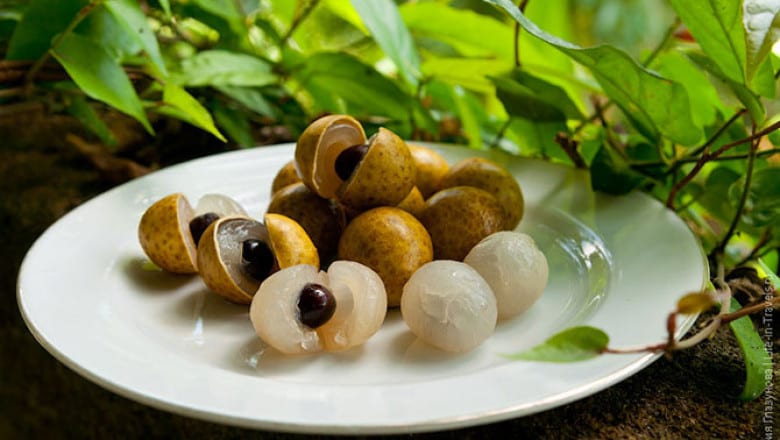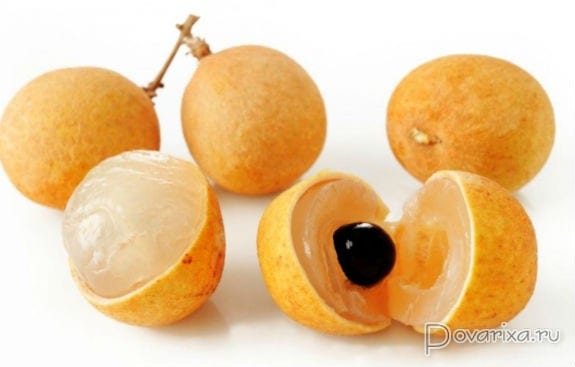Contents
Description
Longan is a delicious exotic fruit, familiar to everyone who has been to Asia at least once. Under the nondescript-looking skin, there is a fragrant and refined-tasting pulp: this fruit does not leave anyone indifferent. An additional bonus is a composition saturated with useful substances for the body, which can give odds to many more popular fruits.
There are two versions of the origin of longan: the origin of the fruit may be China or Burma. The first mention of it dates back to 200 BC. At that time, in the Chinese province of Shenxing, a ruler from the Han dynasty planned to plant beautiful orchards.
Of all the fruits he knew, he chose the finest – longan and lychee, but they did not take root in the cold climate of the northwestern part of the country.

However, in the warmer southern Chinese provinces of Guangdong and Fujian, where the subtropical climate prevails, the fruits ripen perfectly: the country is their main exporter. They are no less popular in Thailand, where they bear the local name lamayaj (Lam Yai). These fruit trees can be found in Cambodia, Indonesia, Vietnam, India, Malaysia, Laos, the Philippines, Sri Lanka, and Taiwan.
Back in the 19th century, Longan was taken out of Asia. Since then, it has been successfully cultivated in Australia, Puerto Rico, and the island of Mauritius. But in Florida and other warm regions of the United States, the plant did not gain popularity among gardeners and farmers, so you will not find large plantations in the region.
Longan Season
Longan fruits ripen on evergreen trees. The crop is harvested once a year: in Thailand and other southeastern countries, the peak of fruiting occurs in the summer, from June to August. However, the variety of climatic conditions allows harvesting all year round in different parts of the region.
In this regard, the fruit can be found on supermarket shelves at any time of the year.
Since a well-ripe fruit is stored for no more than a week even in the refrigerator, it is harvested slightly unripe for export. This does not affect the taste of the fruit, on the contrary, to improve the taste, it is recommended to eat it no earlier than 1-2 days after harvest.

What does it look like
Longan grows on trees of the same name, the average height of which is 10-12 m, but some specimens can reach 40 m. Their feature is a bushy, dense evergreen crown, which can grow up to 14 m wide. The bark of the tree is wrinkled, tough and dense, dark brown in color.
The main thing that attracts people to this plant is its fruits. They ripen on the branches in bunches similar to grapes. The size of the fruit is small – about 2-2.5 cm in diameter: they look like large grapes or nuts. The fruits are covered with a dense, tough, rough skin, the color of which, depending on the variety, can be pale yellow, light beige or brown.
Under the inedible skin, there is a white or slightly pinkish translucent pulp, reminiscent of jelly in consistency: it is it that is eaten. The fruit has a unique taste that is unlike anything else, which combines the sweetness of melon, freshness of kiwi and berry flavor. A special feature is a bright musky aroma.
Longan is slightly sweeter than its closest relative, lychee, but less juicy. Other similar fruits include rambutan and Spanish lime.
Under the pulp is a round or oblong bone, the color of which can be dark or slightly reddish. It cannot be eaten because of the abundance of tannins and sapotin. However, seeds are used to create medicines, are used in cosmetology and folk medicine.
Longan name

Longan is known as “dragon’s eye”: this is the translation of the Chinese word longyan. An ancient legend about a young man named Longan, who figured out how to rid an entire village of an evil dragon, is associated with his appearance. The legend says that he offered to lay out on the seashore from which the dragon emerged, the carcasses of cattle soaked in rice wine. The monster was tempted by the offerings, but got drunk and quickly fell asleep.
Then the brave Longan pierced one of his eyes with a spear and pierced the other with a knife. But even the blind monster entered into a fierce battle that lasted all night. In the morning, the villagers saw the defeated dragon, but the brave youth was also dead. Soon a tree grew on his grave, bearing fruit that looked like those gouged out eyes of the monster.
There really is some truth in this legend. If you separate half of the fruit pulp, the large dark bone remaining in the second part will indeed resemble the pupil of a monster.
Longan benefits
The abundance of vitamins, minerals, amino acids and other components endow Longan with a number of health benefits. One recent study has shown a significant improvement in the condition of patients with damage to the liver and other internal organs, which occurred after regular intake of this fruit.

- Increases immunity and tone, gives vigor, fights apathy, insomnia and irritability, relieves signs of fatigue.
- Due to the iron content, it is prescribed for anemia.
- In folk medicine it is used as an anthelmintic.
- It is used for the prevention of cancer and during chemotherapy.
Contraindications
The balanced composition and the absence of toxic components in it make the use of longan absolutely safe. The only serious risk is individual intolerance, which can cause allergic reactions. For this reason, you should not give it to children under three years old, and also approach the fruit with caution: eat no more than 6-8 berries for the first time.
In addition, longan has a mild laxative effect, so people with gastrointestinal problems need to eat it in moderation. Like all exotics, longan is not familiar to a European person, which can cause similar problems when overeating fruit while traveling.
How to choose Longan
In Asian countries, longan can be found on supermarket and store shelves all year round. It is almost impossible to determine in appearance whether the fruit is ripe or not, so it is worth taking a couple of berries for a sample. If they have a sour taste, the fruit is still “green”: you can choose a different batch or leave the unripe fruit for 1-2 days in a warm place, and then eat it. You should also pay attention to the peel. It should be of a uniform color, free from stains, rot, cracks and damage.
Cooking applications

Traditionally, this sweet fruit is used in desserts and drinks: added to cocktails, ice cream, mousses, cakes. In Asia, coconut milk and longan soup or sweet rice porridge with the addition of this fruit is popular.
It is worth noting the traditional refreshing drink, which has a tonic and refreshing effect. For its preparation, the pitted pulp is boiled in sugar syrup and poured with water.
An interesting way to dry longan. To do this, the pulp is first boiled in syrup, and then placed in the sun, in a dryer or oven for several hours. The result is more high-calorie – about 250 kcal, but even sweeter dried fruits that taste like raisins. They are often added to salads or used as a condiment for rice, fish, or meat dishes.
Exotic Longan is a traditional Asian delicacy that is not often found in regular supermarkets. However, its great taste and abundance of nutrients make the fruit a welcome guest in the diet of every person, regardless of the season.









